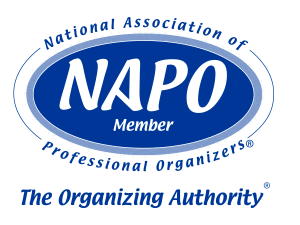 This is “National Simplify Your Life” week.
This is “National Simplify Your Life” week.
Because it’s part of my business name (Organize to Simplify) I’m constantly thinking about what “simplify” means to me, my friends, my family, and my clients.
Here are some things that may need to be simplified in our lives:
- Stuff? Yes!
- Schedules? Yes!
- Technology? Yes!
- People? Yes! (yikes!)
Stuff:
Most of us have way more stuff than we need (and probably even want). Look around the room you are sitting in and really take a hard look at everything that surrounds you. Do you use them? Do they bring you joy and happiness? If not, what would it feel like to let them go? How would it feel knowing that they were in the home of someone that actually needed and wanted them? Not only is it okay to let things go, de-cluttering makes us healthier:
According to the Chicago Tribune: “Getting rid of clutter can have unexpected health benefits. Letting go of material things gives a feeling of euphoria some liken to the runner’s high. It’s liberating and frees up time and space for healthy habits, such as exercising. It can even reduce allergy symptoms and help you lose weight.”
Schedules:
Raise your hand if you feel you have too much to do and not enough time (I can almost see all of your hands raised right now). Do you need to do everything on your schedule? Are there things you knew at the time you should have said “no, but thanks for asking” to? Are you doing things that don’t make you happy and are not critical (book club you no longer enjoy, exercise class you are only attending because you already paid for it but don’t really like, networking meetings that don’t bring you joy or clients, etc.) Much like our stuff, cluttered and over-crowded schedules can affect our health. I encourage you to take a look at your schedule and see what you can eliminate. What would you do with that extra time? Exercise? Sleep? Spend more time with family and friends?
Technology:
Am I actually suggesting you give up technology? Absolutely not!!! What I am suggesting is taking a critical look at how much time you are devoting to it. Personally, I don’t do Twitter, Instagram, or Tumblr, but I spend way too much time on Facebook. What are you learning from all these connections? Is it really a “connection” or just a way to spend time? What would happen if you disconnected from a social media platform or two? What would happen if you reduced the amount of time you spent on them? What would you do with that time? Remember, doing nothing is a perfectly acceptable answer to that question.
People:
This one may sound harsh, but it’s worth thinking about. I could never do without connections to people. I love being around people; being with people fills me with joy. But, are there connections I am spending time maintaining that no longer serve me (or the other person) the way they used to? Think about it. Is the time spent maintaining a relationship disproportionate to the joy the relationship brings you?
“Some people come into your life just to teach you how to let go.” Search Quotes
I’m pretty sure we are all aware of things that could be eliminated from our lives, but it’s so hard to take that first step. So, I’m going to challenge you:
Over the next week:
- Eliminate one item of clutter.
- Cancel one unnecessary appointment.
- Reduce time spent on technology by one hour.
- Take a critical look at one relationship.
Simplify your life . . . one small step at a time.
Cindy Jobs



